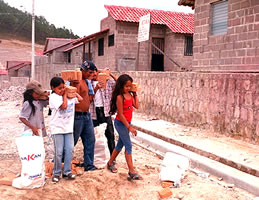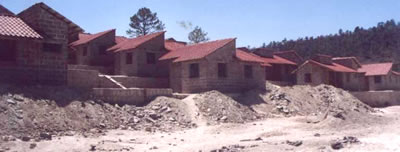La Betania, just another barrio in a satellite city?
When Hurricane Mitch hit Honduras in October 1998, the inhabitants of the neighborhood of La Betania in Tegucigalpa had to abandon their houses and give them over to the swelling river. Four years later they are moving into their new houses in a satellite town 30km outside of Tegucigalpa, the new neigborhood is also called La Betania. This is a project planned and implemented by EcoSouth member EcoViDe in Honduras with funds from the Swiss Red Cross and the Swiss Chain of Solidarity
|
When EcoViDe was entrusted with the reconstruction of Betania, it first had to search for a suitable piece of land, an almost impossible task as land prices kept going up. Together with a planning consultant from Grupo Sofonias and with active consultation with the social organization of La Betania, they decided it would be wrong to follow other NGO´s who simply started building houses out in the mountains surrounding Tegucigalpa. A national study had come to the logical conclusion to back up the establishment of a new economic center in a large valley, on the major road to the second largest city of Honduras. Several industrial complexes had already come to similar conclusions and had begun to build up their facilities, thus creating jobs. The national government finally decided to create a satellite town near this new industrial center and some international NGOs decided to concentrate their efforts there. A delegation from La Betania visited the place, and spontaneously decided to apply for inclusion in the project. EcoSouth partner CIDEM dispatched a town planner to Honduras and, together with the national planning board and the committee of the future house owners, he conceived an innovative settlement design, limiting earth movements to a minimum and creating interesting areas for the 317 projected houses. This was in stark contrast to the rest of the town plan, which consisted of almost 2000 plots lined up in straight rows. The earthmoving for this began, trying to level out as much as possible and felling all the trees, and within days the lovely valley had been converted into a moonscape, Before the area reserved for Betania could be prepared, the Ministry of Environment stopped the works, and after much negotiation the project area was reduced, and Betania was re-assigned into the moonscape, and the careful settlement planning was out. The government prepared the individual plots and terraced them on the hillsides, with retaining walls. In October 2000 the people from Betania started working on the first 20 houses. The varied designs of their roofs stood out strongly against the more simple designs of the other projects. Soon Betania was called the residential area, in spite of the fact that the houses actually are a bit smaller and a lot more economical than the others.  It took them quite exactly two years to build their new barrio and, together with the participants in another EcoViDe project of some 150 houses, they are now ready to move to the new town. The Honduranian government, with the support of the Spanish Government, the Spanish Red Cross and the US Red Cross, is providing a good infrastructure with roads, water, electricity, schools, police station and clinic. Already the first small shops have been set up in private houses and the first churches are being built. The project has been tightly managed and has shown that with intelligent house design and a good management system, attractive and secure projects can be built with little funds. During all moments of construction the financial manager (another cooperation within the EcoSouth Network) was in control of all aspects, and semi-annually a financial analysis was made that allowed for fine-tuning. The project closed well within the budget, in spite of inflation. It is interesting to note, that a major driving force in the social organization was the local chapter of AA (Alcoholics Anonymous). Several of their leaders have also been the motors of the community, and now they are trying to accumulate funds to build their meeting room. |




